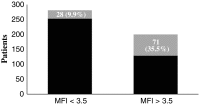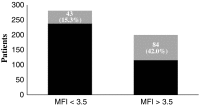Association of a modified frailty index with mortality after femoral neck fracture in patients aged 60 years and older
- PMID: 24166073
- PMCID: PMC3916591
- DOI: 10.1007/s11999-013-3334-7
Association of a modified frailty index with mortality after femoral neck fracture in patients aged 60 years and older
Abstract
Background: Frailty, a multidimensional syndrome entailing loss of energy, physical ability, cognition, and health, plays a significant role in elderly morbidity and mortality. No study has examined frailty in relation to mortality after femoral neck fractures in elderly patients.
Questions/purposes: We examined the association of a modified frailty index abbreviated from the Canadian Study of Health and Aging Frailty Index to 1- and 2-year mortality rates after a femoral neck fracture. Specifically we examined: (1) Is there an association of a modified frailty index with 1- and 2-year mortality rates in patients aged 60 years and older who sustain a low-energy femoral neck fracture? (2) Do the receiver operating characteristic (ROC) curves indicate that the modified frailty index can be a potential tool predictive of mortality and does a specific modified frailty index value demonstrate increased odds ratio for mortality? (3) Do any of the individual clinical deficits comprising the modified frailty index independently associate with mortality?
Methods: We retrospectively reviewed 697 low-energy femoral neck fractures in patients aged 60 years and older at our Level I trauma center from 2005 to 2009. A total of 218 (31%) patients with high-energy or pathologic fracture, postoperative complication including infection or revision surgery, fracture of the contralateral hip, or missing documented mobility status were excluded. The remaining 481 patients, with a mean age of 81.2 years, were included. Mortality data were obtained from a state vital statistics department using date of birth and Social Security numbers. Statistical analysis included unequal variance t-test, Pearson correlation of age and frailty, ROC curves and area under the curve, Hosmer-Lemeshow statistics, and logistic regression models.
Results: One-year mortality analysis found the mean modified frailty index was higher in patients who died (4.6 ± 1.8) than in those who lived (3.0 ± 2; p < 0.001), which was maintained in a 2-year mortality analysis (4.4 ± 1.8 versus 3.0 ± 2; p < 0.001). In ROC analysis, the area under the curve was 0.74 and 0.72 for 1- and 2-year mortality, respectively. Patients with a modified frailty index of 4 or greater had an odds ratio of 4.97 for 1-year mortality and an odds ratio of 4.01 for 2-year mortality as compared with patients with less than 4. Logistic regression models demonstrated that the clinical deficits of mobility, respiratory, renal, malignancy, thyroid, and impaired cognition were independently associated with 1- and 2-year mortality.
Conclusions: Patients aged 60 years and older sustaining a femoral neck fracture, with a higher modified frailty index, had increased 1- and 2-year mortality rates, and the ROC analysis suggests that this tool may be predictive of mortality. Patients with a modified frailty index of 4 or greater have increased risk for mortality at 1 and 2 years. Clinical deficits of mobility, respiratory, renal, malignancy, thyroid, and impaired cognition also may be independently associated with mortality. The modified frailty index may be a useful tool in predicting mortality, guiding patient and family expectations and elucidating implant/surgery choices. Further prospective studies are necessary to strengthen the predictive power of the index.
Level of evidence: Level IV, prognostic study. See Instructions for Authors for a complete description of levels of evidence.
Figures



Comment in
-
CORR Insights®: Association of a modified frailty index with mortality after femoral neck fracture in patients aged 60 years and older.Clin Orthop Relat Res. 2014 Mar;472(3):1018-9. doi: 10.1007/s11999-013-3387-7. Epub 2013 Nov 26. Clin Orthop Relat Res. 2014. PMID: 24276855 Free PMC article. No abstract available.
Similar articles
-
Impact of frailty on outcomes in geriatric femoral neck fracture management: An analysis of national surgical quality improvement program dataset.Int J Surg. 2016 Apr;28:185-90. doi: 10.1016/j.ijsu.2016.02.087. Epub 2016 Feb 27. Int J Surg. 2016. PMID: 26926088
-
What Factors Predict Adverse Discharge Disposition in Patients Older Than 60 Years Undergoing Lower-extremity Surgery? The Adverse Discharge in Older Patients after Lower-extremity Surgery (ADELES) Risk Score.Clin Orthop Relat Res. 2021 Mar 1;479(3):546-547. doi: 10.1097/CORR.0000000000001532. Clin Orthop Relat Res. 2021. PMID: 33196587 Free PMC article.
-
[A 180-day mortality predictive score based on frailty syndrome in elderly patients with sepsis: a Logistic regression analysis model].Zhonghua Wei Zhong Bing Ji Jiu Yi Xue. 2021 Mar;33(3):257-262. doi: 10.3760/cma.j.cn121430-20201027-00688. Zhonghua Wei Zhong Bing Ji Jiu Yi Xue. 2021. PMID: 33834964 Chinese.
-
Proximal femoral fractures in centenarians. A retrospective analysis of 39 patients.Orthop Traumatol Surg Res. 2017 Feb;103(1):9-13. doi: 10.1016/j.otsr.2016.09.025. Epub 2016 Dec 2. Orthop Traumatol Surg Res. 2017. PMID: 27919768 Review.
-
Frailty in orthopaedics: is age relevant?Injury. 2020 Nov;51(11):2402-2406. doi: 10.1016/j.injury.2020.07.031. Epub 2020 Jul 15. Injury. 2020. PMID: 32718751 Free PMC article. Review.
Cited by
-
What do hip fracture patients die from?Eur J Orthop Surg Traumatol. 2023 May;33(4):751-757. doi: 10.1007/s00590-022-03250-x. Epub 2022 Mar 24. Eur J Orthop Surg Traumatol. 2023. PMID: 35377075 Review.
-
Considerations for the Use of Local Anesthesia in the Frail Elderly: Current Perspectives.Local Reg Anesth. 2022 Aug 10;15:71-75. doi: 10.2147/LRA.S325877. eCollection 2022. Local Reg Anesth. 2022. PMID: 35982729 Free PMC article. Review.
-
Association of frailty with adverse outcomes in surgically treated geriatric patients with hip fracture: A meta-analysis and trial sequential analysis.PLoS One. 2024 Jun 21;19(6):e0305706. doi: 10.1371/journal.pone.0305706. eCollection 2024. PLoS One. 2024. PMID: 38905251 Free PMC article.
-
Hemiarthroplasty for Femoral Neck Fracture in the Nonagenarian Population: A Comparative Study on Survival Outcomes.Hip Pelvis. 2025 Jun 1;37(2):120-126. doi: 10.5371/hp.2025.37.2.120. Hip Pelvis. 2025. PMID: 40432177 Free PMC article.
-
Does weightbearing status impact mortality and other complications in hip fracture patients when accounting for frailty?Bone Jt Open. 2025 Jul 8;6(7):785-795. doi: 10.1302/2633-1462.67.BJO-2025-0059.R1. Bone Jt Open. 2025. PMID: 40625097 Free PMC article.
References
MeSH terms
LinkOut - more resources
Full Text Sources
Other Literature Sources
Medical
Research Materials

